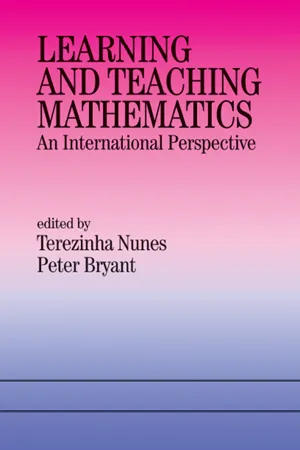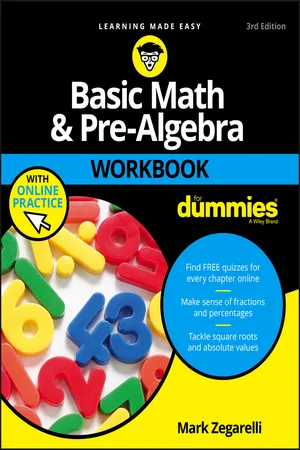Mathematics
Expression Math
Expression math refers to the use of mathematical symbols, numbers, and operations to represent a mathematical statement or equation. It involves combining variables, constants, and mathematical operations such as addition, subtraction, multiplication, and division to create mathematical expressions. These expressions can be used to represent real-world problems, solve equations, and communicate mathematical ideas.
Written by Perlego with AI-assistance
Related key terms
5 Key excerpts on "Expression Math"
- eBook - ePub
Computer Programming for Beginners
A Step-By-Step Guide
- Murali Chemuturi(Author)
- 2018(Publication Date)
- Chapman and Hall/CRC(Publisher)
7 Arithmetic, Relational, and Logical Expressions Introduction to ExpressionsAs we have noted in Chapter 6 , expressions are used in statements. Almost every statement contains at least one expression. Merriam Webster’s dictionary defines an expression generally as “an act of expressing” and “an act of making your thoughts, feelings etc. known by speech, writing or some other method,” and in the context of computer programming, thus, “a mathematical or logical symbol or a meaningful combination of symbols”. Wikipedia defines an expression thus: “an expression in computer programming is a combination of explicit values, constants, variables, operators and functions, that are interpreted according to the particular rules of precedence and of association for the specific programming language.”Let us enumerate the attributes of expressions in the context of computer programming to understand them better: 1. An expression may consist of at least two variables, a constant, or a combination of variables and constants. 2. The variables and constants in the expression are combined using mathematical, relational, or logical symbols, generally referred to as “operators.” 3. The expression is amenable to evaluation using arithmetic, relational, or logical rules.4. The evaluation of an expression in a statement yields only one value that can be used for assignment to a variable or in programmed decision making. That is, expressions can be used in assignment statements and control statements. Expressions are not used in a stand-alone mode.5. Expressions, when used in assignment statements, must be on the right-hand side of the assignment symbol. An expression can never be on the left-hand side of an assignment symbol. - eBook - ePub
- Lawrence A. Trivieri(Author)
- 2011(Publication Date)
- Collins Reference(Publisher)
CHAPTER 11An Introduction to Algebra
I n this chapter, we introduce algebra as a generalization of arithmetic. In algebra, we use letters to represent numbers. Algebraic expressions are discussed, including evaluating and combining them. Removing symbols of grouping is also discussed. In addition, the language of algebra is introduced. Linear equations in a single variable is also discussed, together with the applied problems they can help solve.11.1 EVALUATING ALGEBRAIC EXPRESSIONS In this section, you learn to classify algebraic expressions as sums or products and to evaluate an algebraic expression. ALGEBRAIC EXPRESSIONSIn algebra, letters are used to represent numbers. Such letters are called variables. The numbers are called constants. For example, in the expression × + 3y, the constant is 3; the variables are x and y . An algebraic expression is an expression that consists of constants and variables. Operation symbols and grouping symbols may also be included in the expression.The following are algebraic expressions:- x + y 2 + z3
- –2a +3bc
- 5m 3 – 3q5
- –7xyz
- u 3 –8u + u +
For our purposes, a difference is treated as an algebraic sum. Hence, x – y means x + (–y ). The expression 3u – 2v is called a sum of two terms, which are 3u and – 2v .- The algebraic expression 4t 2 – 3t can be written as 4t 2 + (–3t ). The constants are 4, 2, and –3; the variable is t
- The algebraic expression 3s 4 – 2s – 3 + can be written as 3s 4 + (–2s ) + (–3)
- The constants are 3, –2, and – 3; the variable is s .
In an algebraic expression, a term is part of a sum. Terms are separated by + or – signs. A factor is part of a product.Exercise 11.1Determine whether each of the following expressions is a sum or a product. If a sum, determine the number of terms; if a product, determine the number of factors. - eBook - ePub
Learning and Teaching Mathematics
An International Perspective
- Peter Bryant, Terezinha Nunes(Authors)
- 2016(Publication Date)
- Psychology Press(Publisher)
It is the product of a computation rather than the computation itself. Even if this product cannot be specified at the moment due to the fact that the component number x is unknown, it is still a number and the whole expression should be expected to behave like one. If the context changes, 3(x + 5) + 1 may become yet another thing: a function —a mapping which translates every number x into another. This time, the formula does not represent any fixed (even if unknown) value. Rather, it reflects a change. The things look still more complicated when a letter appears instead of one of the numerical coefficients, like in a (x + 5) + 1. The resulting expression may now be treated as an entire family of functions from R to R. Alternatively, one may claim that what hides behind the symbols is a function of two variables, from R 2 to R. There is, of course, a much simpler way of looking at 3(x + 5) + 1: it may be taken at its face value, as a mere string of symbols which represents nothing. It is an algebraic object in itself. Although semantically empty, the expression may still be manipulated and combined with other expressions of the same type, according to certain well-defined rules. [Emphasis as in the original version.] If all of these interpretations can be hooked to what the authors call an “algebraic” expression, then algebra can be viewed as a notational device for representing various ideas and for manipulating the symbols of these representations but the underlying ideas or concepts can include number, computational process, function, and so on. This is indeed a fairly broad perspective on algebra. Schwartz and Yerushalmy’s view (1992) overlaps somewhat with that of Sfard and Linchevski. But Schwartz and Yerushalmy give even more prominence to functional interpretations in that they have proposed that function is the “primitive algebraic object” (1992, p.264) - eBook - ePub
- Mark Zegarelli(Author)
- 2016(Publication Date)
- For Dummies(Publisher)
Chapter 5 .)Seeing How X Marks the Spot
In math, x stands for a number — any number. Any letter that you use to stand for a number is a variable, which means that its value can vary — that is, its value is uncertain. In contrast, a number in algebra is often called a constant because its value is fixed.Sometimes you have enough information to find out the identity of x. For example, consider the following:Obviously, in this equation, x stands for the number 4. But other times, what the number x stands for stays shrouded in mystery. For example:In this inequality, x stands for some number greater than 5 — maybe 6, maybe , maybe 542.002.Expressing Yourself with Algebraic Expressions
In Chapter 5 , I introduce you to arithmetic expressions: strings of numbers and operators that can be evaluated or placed on one side of an equation. For example:In this chapter, I introduce you to another type of mathematical expression: the algebraic expression. An algebraic expression is any string of mathematical symbols that can be placed on one side of an equation and that includes at least one variable.Here are a few examples of algebraic expressions:As you can see, the difference between arithmetic and algebraic expressions is simply that an algebraic expression includes at least one variable.In this section, I show you how to work with algebraic expressions. First, I demonstrate how to evaluate an algebraic expression by substituting the values of its variables. Then I show you how to separate an algebraic expression into one or more terms, and I walk through how to identify the coefficient and the variable part of each term.Evaluating algebraic expressions
- eBook - ePub
- Mark Zegarelli(Author)
- 2017(Publication Date)
- For Dummies(Publisher)
So to express, you write x 2 rather than xx. To express xxx, you write x 3. An exponent applies only to the variable that it follows, so in the expression 2 xy 2, only the y is squared. To make the exponent apply to both variables, you’d have to group them in parentheses, as in 2(xy) 2. In this chapter, you find out how to read, evaluate, break down, and simplify basic algebraic expressions. I also show you how to add, subtract, and multiply algebraic expressions. Plug It In: Evaluating Algebraic Expressions An arithmetic expression is any sequence of numbers and operators that makes sense when placed on one side of an equal sign. An algebraic expression is similar, except that it includes at least one variable (such as x). Just as with arithmetic expressions, an algebraic expression can be evaluated — that is, reduced to a single number. In algebra, however, this evaluation depends on the value of the variable. Here’s how to evaluate an algebraic expression when you’re given a value for every variable: Substitute the value for every variable in the expression. Evaluate the expression using the order of operations, as I show you in Chapter 4. Q. Evaluate the algebraic expression when. A. 8. First, substitute 3 for x in the expression: Evaluate the expression using the order of operations. Start by evaluating the power: Next, evaluate the multiplication: Finally, evaluate the addition and subtraction from left to right: Q. Evaluate the algebraic expression when and. A. 227. Plug in 5 for x and 3 for y in the expression: Evaluate the expression using the order of operations
Learn about this page
Index pages curate the most relevant extracts from our library of academic textbooks. They’ve been created using an in-house natural language model (NLM), each adding context and meaning to key research topics.




